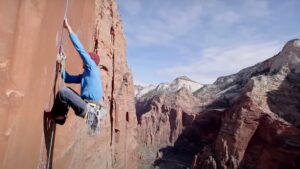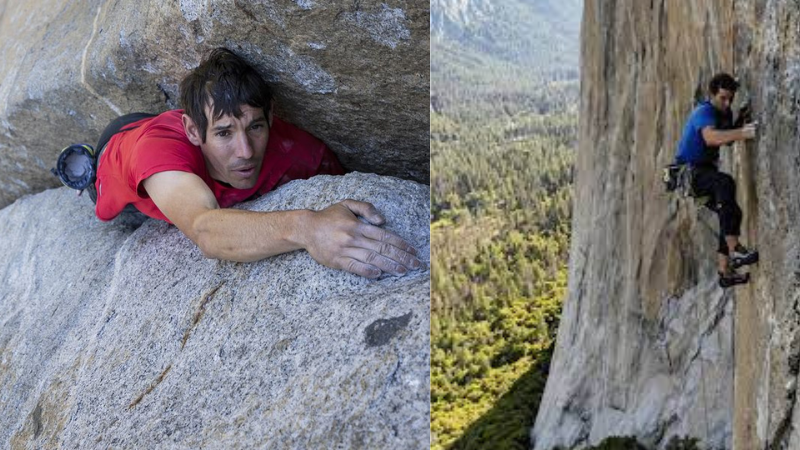Getting down from a mountain peak is an integral part of mountaineering or alpinism and shouldn’t be tougher than and basically different from climbing up the mountain. But the shocking death of famous alpinist Marc-Andre Leclerc and near-death fall of Alex Honnold has turned a usual curiosity into a novice mountaineers’ concern.
Earlier, questions like how do alpinists get down or how do rock climbers get down were a curiosity but now after those incidents, alpinists give a damn about this. But to avoid the most unwanted, the techniques and methods have remained the same, undeterred by the concern.
A run-down of the popular techniques’ alpinists apply for getting down includes hiking, lowering, rappelling, down climbing, and base jumping. And depending on the routes to get down; it may require a single method or a combination of multiple methods mentioned here.
It is worth noting that alpinists should always assess the situation carefully before deciding how to descend from a mountain. Factors such as weather conditions, altitude sickness, fatigue levels, and personal experience should all be taken into consideration when making this decision.
This article will discuss all the efficient ways of getting down from the peak and other crucial matters that may ease and require getting down off the mountain top safely.
Is Alpinism Solo Climbing?
Simply put, Alpinism refers to the act of mountain climbing. One can choose to climb the Alps or any other high mountain when it comes to mountaineering. So, an Alpinist is no different from a mountain climber in general.
However, you must be a serious mountain climber and not one who does it just for fun to be an alpinist. For instance, if you are fond of climbing Mount Everest, you qualify to be called an Alpinist. Let’s single out the subtle difference between the two for your better understanding.
To start with, mountaineering refers to the conventional siege tactics where one ascends and descends the mountain several times before they reach the summit with a group. On the other hand, Alpinism emphasizes fast and light ascents based on individual strength and skills rather than being with a group.
With mountaineering, you will always find shorter routes to the summit and always endeavor to acclimate before reaching the summit. That can take several days and even weeks.
Whereas alpinism is a kind of solo climbing and so faster and lighter as you ascend alone. Alpinism means going to the summit with all your gear and then spending a few days in the mountains. With Alpinism, you will not need to camp as you would with mountaineering and thus will spend less time in the mountains.
So, it will not be wrong to term alpinism solo climbing to be precise. Obviously, you must be optimized to the best of your ability in terms of equipment, techniques, and skills as you ascend atop alone.
6 Methods Alpinists Used to Get Down Safely
Ever wondered how climbers get down from Mount Everest or the Alps? Well, there is a myriad of methods that can help you get down safe and unhurt. From rappelling to lowering, a plethora of methods can help an Alpinist get down the mountains.
As hinted earlier, the method to get down a mountain will depend on the Alpinist’s route. Sometimes, one method can work magic. However, there are instances when you might need a combination of two or more techniques. In the subsequent sections, we shall discuss these methods for your better understanding:
Hiking/Walking Down
Unlike other conventional methods of getting down a mountain, this one is considered to be ideal for most mountaineers. Thankfully, it is less technical, and thus, it is mostly used by many Alpinists, especially the novices.
All you need to do is identify a walk-down route so you can descend the mountain fast. You must go through several bushes and thickets and climb down gullies before reaching the starting point.
Hiking down is less physically demanding than rappelling or other technical descents and so a preferred method by the solo climbers, after spending hours climbing up to the summit. It allows them to move at a steady pace while keeping their balance and avoiding risky maneuvers.
To hike down, you must carefully choose your route based on the terrain and weather conditions. You must have proper hiking gear such as sturdy boots, trekking poles, and a backpack with essential supplies like water and food. You will know that taking breaks is necessary during the descent to avoid exhaustion and dehydration. And it’s important for mountaineers to pace themselves so they can safely navigate the steep trails.
However, hiking down can be a safer option only if the terrain is not too steep or dangerous and it requires preparation, endurance, and caution in order to ensure a safe descent.
Lowering
Besides hiking or walking down, lowering is another method to help you descend a mountain. During this process, one climber usually lowers their colleague down a cliff using a climbing rope.
Although this method can be a lifesaver whenever you want to descend a high mountain, one needs to be extra careful as it involves a number of risks. You must ensure that you have a long rope for descending the mountain – not shorter than double the height of the point you have ascended using an ascender. So, ascending a rope and descending it is a crucial mountaineering skill to master over. Besides this, you should ensure that you tie a stopper knot on the free end to prevent the rope from slipping through the device used to fasten it.
Rappelling/Abseiling
First and foremost, abseiling and rappelling mean the same thing. Here, an Alpinist uses a piece of rope to perform a controlled descent. Unlike the previous method where you had a friend lowering you down a cliff, rappelling involves descending yourself using a rope. If you have been wondering how solo alpinists get down the mountain, rappelling or abseiling is their ultimate method.
However, if you are a free solo climber, you must bring a rope to use to descend the mountain via rappelling. During this process, the climber usually relies on a belay device to create the much-needed friction so that he can descend the mountain safely. Ideally, the rope goes through the device, allowing the climber to get down the mountains more conveniently.
Although this method is ideal for getting down a high mountain, one has to ensure that the rock is clean. Besides this, your rope must be able to reach the ground or the starting point. Additionally, you need to consider whether you can retrieve the protection hardware being set up and the rope without essentially having to snag it during the rappelling process.
Lowering Versus Rappelling
The methods mentioned above entail the use of ropes to descend a mountain. However, these methods differ in several aspects. To start with, lowering requires the participation of two people. Here, one person lowers the other one down the mountain.
During rappelling, only one person is involved. Here, they use a rope to make their way down the mountain. Compared to lowering, rappelling is deemed to be fast. Better still, it can work a spell if you want to enable an injured climber to reach the ground more conveniently.
Down Climbing
As you get off a high mountain, you will come to some steep sections composed of rock and other elements. Unlike other places, these sections might be loose, with the presence of broken stones.
If you have to get down a mountain on such sections, you must consider down climbing. Here, you might have to use climbing ropes to reach the bottom without falling or slipping.
Base Jumping
Unlike the methods mentioned above, this one is more of a sport than a technique of getting down a high mounting. However, Alpinist still uses it to reach the ground safely. Simply put, this technique involves jumping from the summit’s peak to a base camp or a flat surface.
Although this method can be a lifesaver for some Alpinists, it is essential to note that it is more ideal for lesser mountains or rocks. In addition, it calls for intense training before one can deploy this technique to descend a mountain.
In fact, it has become a preserve of experienced jumpers. However, solo climbers have intense training and are now full-fledged base jumpers. Thankfully, it can be a recreational activity and if you combine it with free solo climbing, be sure that you will have an unmatched experience.
High-Risk Exposure
Alpinism is full of adventure and no wonder it will be a risky endeavor. This is because climbing usually exposes you to a number of challenges. The grave one is, you might encounter bad weather as you ascend or descend the mountain. Such is usually the case if you climb a mountain during the winter or cold months.
You might also experience a number of serious injuries as you try to scale the mountain up and down. Some climbers have had to grapple with a lack of oxygen while on the mountains.
Other times, you might experience extreme fatigue or tired muscles. Besides this, you might come across slippery paths before you reach the mountaintop. Finally, you should brace yourself for possible frostbite and avalanches. To be on the safe side, you should ensure that you have the proper gear and supplies in order to have a smooth mountain climbing experience.
And alpinism being mostly a solo climbing adventure, you must be prepared to the best to survive all the risky situations you are likely to encounter.
Marc-André Leclerc and other Famous Alpinists
Although we have outlined the various methods that alpinists get down from a mountain peak, you need to know how the famous Alpinists scaled down the mountain so that you can have a better understanding. Here you go with top alpinist techniques:
Marc-André Leclerc
To start with, Marc-Andre Leclerc was born in Canada. When it comes to mountain climbing, he was good at solo, and mixed climbing. For instance, in 2015, he actually made the first solo ascent on Corkscrew on Cerro Torre.
Unlike other mountain climbers, Marc-Andre Leclerc dared to make solo ascents on difficult or high mountains worldwide. More so, he did several solo ascents on peaks located in British Columbia. He continued making solo ascents until March 2018, when he and his counterpart Ryan Johnson passed on after climbing the Mendenhall Tower’s North Face using a new route. On their descending, they got caught in an avalanche, and their bodies were never recovered even years later.
Alex Honnold
Besides Marc-André Leclerc, Alex Honnold has made several solo ascents on big walls. Alex Honnold is a renowned American rock climber who has achieved incredible feats in the world of climbing. He was born on August 17, 1985, in Sacramento, California and started climbing at the age of five. However, it was not until his early twenties that he began to take climbing seriously and pursue it as a career.
Honnold is best known for his free solo climbs – which means he climbs without any equipment or ropes to protect him from falls – of some of the most challenging rock faces in the world. His most notable achievement came in June 2017 when he became the first person ever to climb El Capitan’s Free rider route without ropes, an ascent that took him just under four hours.
In addition to his solo climbs, Honnold has also completed numerous impressive ascents with partners including Tommy Caldwell and Kevin Jorgeson. His accomplishments have earned him numerous awards and accolades within the climbing community and beyond.
Free Solo, the Documentary on him, is a captivating and inspiring look at one Honnold’s quest to push himself beyond what anyone thought was possible. It serves as a reminder of how far human potential can be pushed when we commit ourselves fully to chasing our dreams.
Tommy Caldwell
Apart from the above-mentioned rock climbers, Tommy Caldwell is another avid mountain climber. In fact, he has dared several Alpine ascents in the recent past. He also performed a number of free solo ascents in the past that several successful ice climbing ascents.
During the ascents that involved ice climbing, he used ice tools to enable him to reach the mountain’s summit. To allow him to remain warm, he used to wear a pair of gloves and other warm clothes. Having made several solo ascents, he gained the much-needed climbing experience, which is the main ingredient in making challenging Alpine ascents.
How Do Rock Climbers Get Down?
As the adage goes, what goes up must come down. Therefore, if you have been involved in rock climbing, you must go down to where it all started. When it comes to descending a mountain, one single or several methods can help you get started but the most common ones for rock climbers include hiking, rappelling, and lowering.
First, choose to hike down as it is deemed to be safer than other methods. But be sure that the route to hike down is less sloped than other side of the rock wall.
Better still, you can choose to be lowered or consider rappelling. Finally, you can consider base jumping if at all you have perfected that. Either of these methods can work well for you depending on the mountain you are climbing down, the available gear at the top, your skill set, your resilience, the distance involved, and so forth.
But the most popular technique followed by most of the rock climbers is rappelling or lowering off the peak using a fixed anchor made of several bolts drilled into the rock wall. As you see in the picture above, the bolts are connected by lowering rings with chains/ropes running through them.
How Do Climbers Get Down From El Capitan?
Most climbers usually get down from El Capitan by choosing one of the main trails down to camp four. To make things easier, the team usually hikes to the top with supplies such as food and water so that climbers can take something before climbing down. Alex Honnold and other free soloists also walked back down to the base. While walking back down, you have four popular routes to get down along and they all have their pros and cons.
The Steepest East Ledges Descent: The fastest but the toughest option to get to the valley. It is the most popular option for veteran climbers.
Yosemite Falls Trail to Hike (Steep) Down: The easier alternative to rappelling and the most popular trail to hike down EI Captain. It is a zigzagged and steep hike leading to the base EI Captain.
The Less Sloped Tamarack Flat: A longer hiking route but less steep than the previous route. If you are camped at West EI Captain, it is the safest and easiest getting down.
Old Big Oak Flat Hiking Trail: This is an alternative and similar to the Tamarack route running 6.5 miles westward hike. It is like finding the route and getting where to reach.
They are so far the most popular means climbers follow to get down from EI Captain but there are other ways of getting down from here.
How Do Climbers Get Their Gear Back?
Getting gears back is an obsession for climbers as some gears are way too expensive to buy anew for every session of climbing. The three things you used while climbing can be retrieved include anchor, rope, and quickdraws. There are trad and aid gears used but they are left behind generally if not that costly a tool.
The three gears mentioned require different techniques to retrieve them. While getting back anchor and quickdraws are same as removing anchor will take quickdraws along, the retrieving of rope is quite different.
The process of retrieving gear will vary to a significant extent for different types of climbing. To point out, you can get back the used gears as soon as you reach the upper anchor while climbing multi-pitch.
Your second climber can collect all the gears used by you as you will belay him up now. but the thing is not easy for solo climbers, he must rappel down to every anchor and after that releasing the rope and anchor is not that easy lacking the support of a belayer.
How Do Climbers Get Their Anchors Back?
Yes, you can get your anchors back but you have to be prepared to leave them back because situation may demand it sometimes.
You may have to leave your anchor (quickdraws, bolts, cams and the likes) back for other climbers next to have a ready anchor. Thus, the next climbers won’t need to leave their gears back. Alternative is, lowering back to the anchors and replace them with cheaper anchors and take back your high-end gears back.
If you are a free climber, you will use minimal or no gear to retrieve. But if you climb solo or do multi-pitch with your partner, you will use so many aids to get them back.
As for solo climbers, this is simply done by rappelling down – stopping at every anchor and collecting the gears. And for climbing with partner, the second climber or belayer can retrieve the anchors as he is belayed by the lead climber up.
Yes, retrieving anchors is easier in aid climbing than doing it in solo climbing. But do not go relaxed while doing it while doing it with partner because you are still overhanging in challenging routes.
How Do Free Climbers Get Down?
In most cases, free solo climbers usually descend mountains by walking down on the easiest part of the mountain. Other times, they opt to climb relatively taller mountains so that they can have an easy time climbing down. Some use fixed ropes to descend different mountains.
Whereas this is a pointed answer to the query how do solo alpinists get down the mountain, techniques for solo and other climbers are the five methods discussed above.
In the picture, you see the famous soloist climbing down EI captain. Though the key technique for solo climbers is hiking down, it can be mix of many methods. Especially, the shorter and steep section of the route is covered through down climbing. Whatever, the stake is to safely land on the mountain foot.
How Do Climbers Get Down from Everest?
In most cases, climbers get down this mountain using the same route they used to ascend it. There is no rule of the thumb when it comes to how one can descend this mountain. As long as your path does not have a lot of resistance, you can consider it, and you will be able to reach the base camp successfully.
But there are examples set by some climbers who got down to the base camp faster by following some unconventional methods not mentioned in this guide. These methods include skiing, snowboarding, and paragliding.
Davo Karnicar made it to the base camp from the summit in five hours by skiing. Lean-Marc Boivin reached Camp 2 starting from below the Summit in just 12 minutes by paragliding. And Marco Siffredi and Stefan Gat are the two trend-setters who snowboarded all the way down to the base camp.
Among the conventional methods, doing fixed ropes (sherpas replace the old fixed ropes every season by setting them afresh), rappelling, walking and lowering are the most common. Being the highest mountain in the world, it takes several base camping before reaching the foot.
What General Climbing Down Rules Should I Follow?
Following the basic rules is a must to increase safety while getting down a mountain. Here you go with the crucial climbing rules.
- When descending a mountain or a rocky surface, ensure that your knees are slightly bent.
- Ensure that you take shorter steps all the time. By doing so, you will be able to maintain the gravitational pull.
- Make sure to fasten your hip strap as you descend the mountain, especially if you are on a loose and uneven surface. This way, you will be able to retain the much-needed equilibrium.
- During lowering, ensure that you flow with the terrain. This will go a long way in reducing body pressure.
- When descending a mountain, ensure that you maintain maximum concentration to avoid potential accidents.
- When getting down a rocky mountain surface, ensure that you do not lean forward or backward. By doing so, the force of gravity will be above the knee area.
FAQs
How Do Climbers Get Their Ropes Back?
It is imperative to note that climbers hardly tie ropes on the top anchor. This is because the rope is usually doubled and usually has a figure-8 that prevents the rope from sliding through two anchor points. The anchor, on the other hand, usually has nylon webbing and a number of opposing carabineers clipped to it.
In most cases, the climbing ropes are usually fed through the carabineers as the climber descends the mountain using one side of the string. Once the climber reaches the bottom of the mountain, they will need to pull on one end of the rope so as to release the ‘8s’ from the anchor points. Thus, the climber can get his or her ropes back.
Can You Get Down from a Mountain Alone?
Yes. If you are a solo climber, be sure that you can get down a mountain alone. While getting down a mountain alone is faster, it is way difficult and risky and so the job of a veteran alpinists only.
You must be well adapting to rappelling and self-belaying if you want to get down safely and successfully. Knowing about how the famous mountaineers did it alone while summiting the tallest mountains is mandatory to get the needed exposure.
Can You Self Belay to Get Down a Mountain?
Yes. Here, you will be using a piece of belaying equipment to descend a mountain. To make self-belaying possible, you will have to use a special equipment called self belay. Moreover, you have to use an ice axe to prevent sliding down a surface that is covered by snow.
In traditional belaying, one belayer helps you climb up and ensure your safety while getting down. But in self-belaying, you are the climber and belayer but there is the self-belaying machine to make your job easier.
Fundemental Skill for Alpinists to Get Down
We hope your queries or concerns are well met in this how do alpinists get down guide. From hiking to base jumping, several methods can help an alpinist to get down a mountain.
If you have a passion for mountaineering, you must master all the techniques mentioned above. They can help you descend a mountain quickly and safely. But rappelling down is the fundamental trick to master as a solo climber.
As for getting down Everest and other summits like it, there are examples of unconventional methods for a change if not essential.






